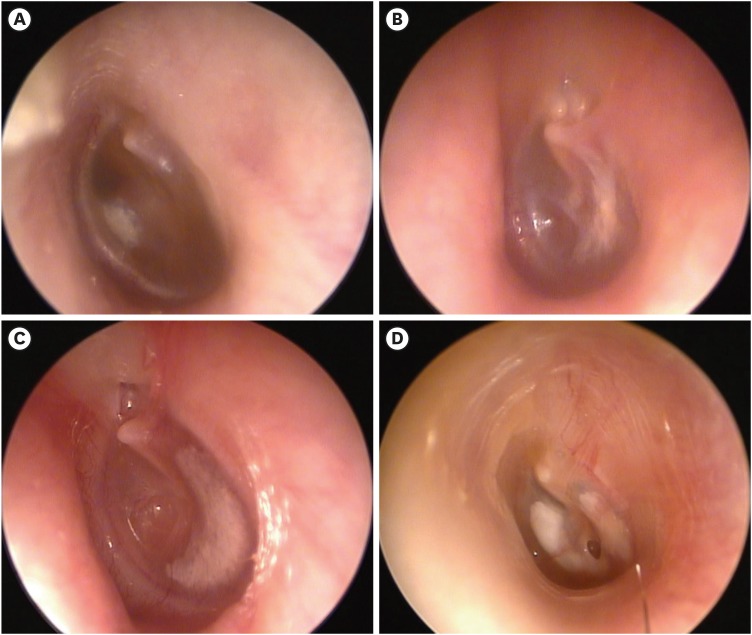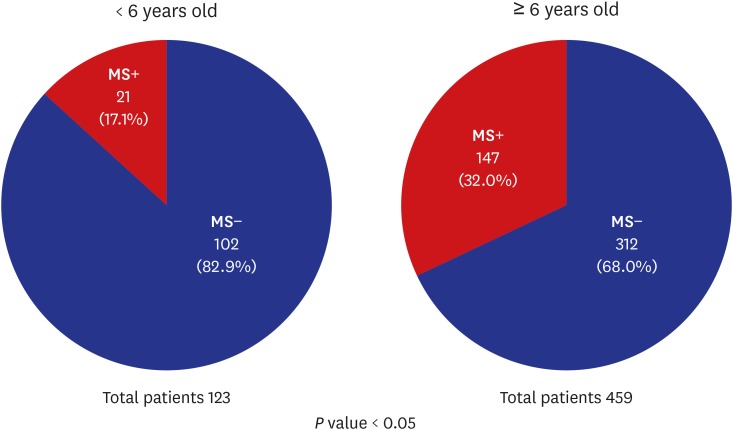J Korean Med Sci.
2020 Apr;35(13):e83. 10.3346/jkms.2020.35.e83.
Analysis of Risk Factors for Myringosclerosis Formation after Ventilation Tube Insertion
- Affiliations
-
- 1Department of Otolaryngology-Head and Neck Surgery, College of Medicine, Chungnam National University, Daejeon, Korea.
- 2Brain Research Institute, College of Medicine, Chungnam National University, Daejeon, Korea.
- KMID: 2509605
- DOI: http://doi.org/10.3346/jkms.2020.35.e83
Abstract
- Background
This study examined possible risk factors for myringosclerosis formation after ventilation tube insertion (VTI).
Methods
A retrospective study was performed in a single tertiary referral center. A total of 582 patients who underwent VTI were enrolled in this study. Patients were divided into two groups based on the presence or absence of myringosclerosis: MS+ and MS−. Characteristics of patients were collected through medical chart review; these included age, gender, nature and duration of effusion, type of ventilation tube (VT), duration and frequency of VTI, incidence of post-VTI infection, incidence of intraoperative bleeding, and presence of postoperative perforation. Incidences of risk factors for myringosclerosis and the severity of myringosclerosis in association with possible risk factors were analyzed.
Results
Myringosclerosis developed in 168 of 582 patients (28.9%) after VTI. Patients in the MS+ group had an older mean age than those in the MS− group. The rates of myringosclerosis were higher in patients with older age, serous otitis media, type 2 VT, post-VTI perforation, and frequent VTI. However, there were no differences in occurrence of myringosclerosis based on gender, duration of effusion, duration of VT placement, incidence of post-VTI infection, or incidence of intraoperative bleeding. The severity of myringosclerosis was associated with the duration of effusion and frequency of VTI.
Conclusion
Older age, serous effusion, type 2 VT, presence of post-VTI perforation, and frequent VTI may be risk factors for myringosclerosis after VTI; the severity of myringosclerosis may vary based on the duration of effusion and frequency of VTI.
Figure
Reference
-
1. El-Anwar MW, El-Aassar AS, El-Sayed H. Myringosclerosis in children with chronic renal failure on regular hemodialysis. Indian J Otol. 2015; 21(4):238–242.
Article2. Ozcan C, Görür K, Cinel L, Talas DU, Unal M, Cinel I. The inhibitory effect of topical N-acetylcysteine application on myringosclerosis in perforated rat tympanic membrane. Int J Pediatr Otorhinolaryngol. 2002; 63(3):179–184. PMID: 11997152.3. Selcuk A, Ensari S, Sargin AK, Can B, Dere H. Histopathological classification of tympanosclerotic plaques. Eur Arch Otorhinolaryngol. 2008; 265(4):409–413. PMID: 17962967.
Article4. Gibb AG, Pang YT. Current considerations in the etiology and diagnosis of tympanosclerosis. Eur Arch Otorhinolaryngol. 1994; 251(8):439–451. PMID: 7718216.
Article5. Uneri C, Bağlam T, Yazici M. The effect of vitamin E treatment on the development of myringosclerosis after ventilation tube insertion. Int J Pediatr Otorhinolaryngol. 2006; 70(6):1045–1048. PMID: 16368152.
Article6. Khodaverdi M, Jørgensen G, Lange T, Stangerup SE, Drozdziewizc D, Tos M, et al. Hearing 25 years after surgical treatment of otitis media with effusion in early childhood. Int J Pediatr Otorhinolaryngol. 2013; 77(2):241–247. PMID: 23218983.
Article7. Yaman H, Guclu E, Yilmaz S, Ozturk O. Myringosclerosis after tympanostomy tube insertion: relation with tube retention time and gender. Auris Nasus Larynx. 2010; 37(6):676–679. PMID: 20392579.
Article8. Asiri S, Hasham A, al Anazy F, Zakzouk S, Banjar A. Tympanosclerosis: review of literature and incidence among patients with middle-ear infection. J Laryngol Otol. 1999; 113(12):1076–1080. PMID: 10767919.
Article9. Bhaya MH, Schachern PA, Morizono T, Paparella MM. Pathogenesis of tympanosclerosis. Otolaryngol Head Neck Surg. 1993; 109(3 Pt 1):413–420. PMID: 8414556.
Article10. Kim BJ, Kim J, Park IY, Jung JY, Suh MW, Oh SH. Effects of transient auditory deprivation during critical periods on the development of auditory temporal processing. Int J Pediatr Otorhinolaryngol. 2018; 104:66–71. PMID: 29287884.
Article11. Branco C, Monteiro D, Paço J. Predictive factors for the appearance of myringosclerosis after myringotomy with ventilation tube placement: randomized study. Eur Arch Otorhinolaryngol. 2017; 274(1):79–84. PMID: 27395069.
Article12. Kay DJ, Nelson M, Rosenfeld RM. Meta-analysis of tympanostomy tube sequelae. Otolaryngol Head Neck Surg. 2001; 124(4):374–380. PMID: 11283489.
Article13. Luntz M, Sadé J. Growth of the eustachian tube lumen with age. Am J Otolaryngol. 1988; 9(5):195–198. PMID: 3228177.
Article14. Takasaki K, Sando I, Balaban CD, Haginomori S, Ishijima K, Kitagawa M. Histopathological changes of the eustachian tube cartilage and the tensor veli palatini muscle with aging. Laryngoscope. 1999; 109(10):1679–1683. PMID: 10522942.
Article15. In : Casselbrant ML, Brostoff LM, Cantekin EI, Ashoff VM, Bluestone CD, editors. Otitis media in children in the United States. Proceedings of the International Conference on Acute and Secretory Otitis Media; 1985 Nov 17-22; Jerusalem, Israel. Amsterdam: Kugler Publication;1986. p. 161–164.16. Bylander A, Tjernström O. Changes in Eustachian tube function with age in children with normal ears. A longitudinal study. Acta Otolaryngol. 1983; 96(5-6):467–477. PMID: 6637457.17. Bluestone CD. Eustachian Tube: Structure, Function, and Role in Otitis Media. Hamilton: BC Decker Inc.;2005.18. Akyıldız N. Kulak hastalıkları ve mikrocerrahisi. In : Akyıldız N, editor. Kulak Hastalıkları ve Mikrocerrahisi 1. Ankara: Bilimsel Tıp Yayınevi;1998. p. 461–472.19. Mattsson C, Marklund SL, Hellström S. Application of oxygen free radical scavengers to diminish the occurrence of myringosclerosis. Ann Otol Rhinol Laryngol. 1997; 106(6):513–518. PMID: 9199613.
Article20. Karlidağ T, Ilhan N, Kaygusuz I, Keleş E, Yalçin S. Comparison of free radicals and antioxidant enzymes in chronic otitis media with and without tympanosclerosis. Laryngoscope. 2004; 114(1):85–89. PMID: 14710000.21. Branco C, Paço J. Does calcemia influence the onset of myringosclerosis after myringotomy with the insertion of ventilation tubes? Acta Otorrinolaringol Esp. 2017; 68(6):323–327. PMID: 28522133.
Article22. Park YH, Park CH, Kim HJ. The effect of topical sodium thiosulfate in experimentally induced myringosclerosis. Laryngoscope. 2010; 120(7):1405–1410. PMID: 20583241.
Article23. Akdagli S, Tuzuner A, Demirci S, Karadas H, Tulaci KG, Dogan M, et al. Do all antioxidant supplements have the same potential effect on preventing myringosclerosis? Clin Exp Otorhinolaryngol. 2015; 8(1):1–6. PMID: 25729488.
Article24. Arslan N, Tepe D, Taştan E, Demirci M, Caydere M, Ustun H, et al. Evaluation of the effectiveness of topical ciprofloxacin and prednisolone in the prevention of myringosclerosis. Eur Arch Otorhinolaryngol. 2012; 269(11):2335–2341. PMID: 22197890.
Article25. Erdurak SC, Coskun BU, Sakalli E, Tansuker HD, Turan F, Kaya D. Does the use of radiofrequency myringotomy for insertion of a ventilation tube reduce the incidence of myringosclerosis? Eur Arch Otorhinolaryngol. 2014; 271(3):459–462. PMID: 23494285.
Article
- Full Text Links
- Actions
-
Cited
- CITED
-
- Close
- Share
- Similar articles
-
- Clinical Study of Laser Myringotomy with Ventilation Tube Insertion on Pediatric Chronic Otitis Media with Effusion
- Grommet Cholesteatoma
- Factors That Affect the Development of Tympanosclerosis after Ventilation Tube Insertion
- Risk factors for persistent otitis media with effusion in children: a case-control study
- Structure of the Ventilation Tube





